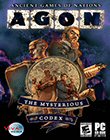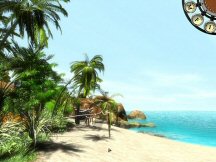AGON: The Mysterious Codex
is a compilation on CD of three games featuring the adventures of
Professor Samuel Hunt of the British Museum. The games originally were
(actually, still are) available as self-contained individual downloads.
AGON: The Mysterious Codex maintains this episodic character and
you must complete each episode before you can continue to the next one.
Our protagonist is a “scientist of culture,” a lover of history, and an
unlikely hero. He’s in his early 50s -- an age at which most folks are
too worn out to go gadding about the globe on eccentric quests. The game
takes place at the beginning of the 20th century. The London
episode opens with Professor Hunt working late into the night, surrounded
by leather-bound volumes which presage some of the locations and mysteries
the gamer will encounter. Professor Hunt has just received a letter from
an anonymous source. It contains a page from an unknown Codex (ancient
manuscript) and a hint that this strange document is somehow related to an
artifact in the museum’s collection.
Professor Hunt’s character is one of the strengths of AGON –
after a brief time in his company you understand his intellectual zeal,
and you sense his magnetic personality. It is his mission to acquire
twelve long lost board games (the Ancient Games Of
Nations), which were given long ago to twelve families across the
globe. Hunt must not only locate each family, but he must also beat the
current master/caretaker at his own game. AGON: The Mysterious Codex
chronicles Professor Hunt’s quest for the first two Ancient Games.
And So It Begins
Part of the fun of playing AGON is the chance to explore the
exotic locations in a colorful, historical past. Once Professor Hunt
zeros in on the first Ancient Game, it’s off to Lapland for some intense
sleuthing and negotiations with the locals. You will visit a Laplander
village and wander among snowy vistas looking for people and clues.
Graphics are node-based, using first person perspective with 360 degree
panning. The interface is point-and-click. The graphical resolution is
not as sharp as I’ve seen in recent games. But while exploring the
environments that is a minor issue.
Lapland is so well rendered that you actually feel the cold. Tree
trunks are contorted, weighed down by their ice encrusted branches. The
Laplander huts are huddled, smoke rising from the chimneys. There is a
sleigh ride here that is affectingly nostalgic, through a windswept forest
mantled in snow.
Conversation with the Laplanders and other characters in the game takes
place via a dialog box at the bottom of the screen. Questions can be
asked in any order. I couldn’t click through the dialogues, but
conversations are sufficiently succinct that I didn’t need to speed
through them anyway. The voice acting throughout the game is excellent,
particularly that of Peter Meikle in the role of Professor Hunt.
Each location features ethnic music authentic to the locale; the
musical loop is short, provocative and memorable.
Once Professor Hunt has located Tablut -- the Ancient Game in Lapland
-- and has beaten its master, the episode closes abruptly. Then, while
you are still trying to catch a glimpse of the mysterious stone Hunt has
just acquired, he is heading toward another part of the world –
Madagascar, as lush and vibrant as Lapland is icy and stark.
Out of the Freezer and Into the Tropics
A quick transition between episodes is provided by a map of the globe
with Professor Hunt’s travels traced on its surface. Next to the map are
letters detailing his experiences while in transit, as well as an excerpt
from his biography.
It’s in Madagascar that AGON really settles into what it does
best -- immersing the gamer in a remote, treacherous environment, creating
hazards for the Professor to overcome in his quest, and introducing
characters who tell a touching story. Madagascar is longer than the other
episodes -- with more backstory and greater interaction with other
characters.
The Madagascar jungle is a labyrinthine tangle made up of thorny
branches, tall grasses and silhouettes of leaves against the sky. Deep
within is a treehouse, surely inspired by the abodes of famous fictional
castaways. AGON’s treehouse has gauzy, netted curtains blowing in
the breeze and it’s strewn with books and remnants of technology from
across the ocean. Late in the episode, you exit the jungle and explore
the beach where a flamboyant sunset paints the water and sky. The final
path to the Fanorana Ancient Game is surprising, as is the game’s master
(and his unpronounceable name).
Try to Consider the Whole Board Simultaneously, Professor
The Lapland and Madagascar segments are punctuated at the end by an
Ancient Game that you must win to complete the episode. I played both
board games on the “Easy” setting, designed for people who don’t often
play them. Winning at Tablut wasn’t too difficult, but Fanorana was hard
because the moves are more complex. I felt a sense of accomplishment each
time I defeated my opponent. Overall, I think the board games are a novel
and successful addition to this particular adventure series. Once you’ve
beaten them, you can go to the main menu and play against the computer as
often as you’d like. After practicing against your virtual opponent, you
may find that you wish to play these
games
online against flesh and blood opponents – though I couldn’t discover
a way to do this using The Mysterious Codex disk.
Dot Dot Dot Dash Dash Dash Dot Dot Dot
AGON is a puzzle-heavy game and includes inventory, mechanical,
and pixel-hunting challenges. I struggled mightily in AGON,
particularly with a puzzle type I haven’t mentioned yet -- symbol
interpretations. There are several places in the game where texts have to
be decoded, then entered into a pop-up keyboard. Make one tiny error
while decoding/translating these texts, and the game simply sits there,
giving you no indication where you went wrong in this complicated,
time-consuming process.
The longest puzzle of this type – the Morse Code puzzle – was fun for
about the first thirty letters. It was not fun for the next sixty. After
laboriously distinguishing dots from dashes, the game still didn’t credit
me with the solution, and I had to glance at a walkthrough to see why
not. After I finally realized the last “twist” and entered everything
correctly, I did not find much reward for my efforts – the solution gave
me information, but nothing in the game seemed to have changed at all.
I found other problems. The physical proportions of a few of the
puzzle items in AGON made it difficult to understand how they
related to one another or to the task at hand. One goal could not be
achieved until a tangential puzzle was solved that had no “real” effect
upon the goal. Too often it was easier to solve challenges through trial
and error than to figure out the clues. A couple of times I didn’t even
find the clues until after I’d solved the puzzle. Twice I missed
inventory items altogether, and couldn’t return for them. After
consulting a walkthrough, I had to go back to a saved game to correct my
mistakes.
At times I knew that something was a clue, but I couldn’t see it
because it was blurry or because it was a symbol that was almost
indistinguishable from another symbol. In one sequence, I literally had
to put my nose up to the screen to make out the shape of the clues. For a
sound based puzzle, I had to put my ear right up to each computer speaker
before I could distinguish the clues. I’ve never played a game that
forced me get so up close and personal with my computer.
AGON cries out for an in-game hint system. The first level of
hints for the decoding challenges should be the text/symbol clues printed
in a clear, black, standard font; for the sound based puzzle, a
description of the sounds and direction they are coming from would be
useful.
Housekeeping
AGON’s interface is easy to use. In rare instances, navigation
became frustrating while I searched for the directional arrow between
nodes, but otherwise interacting with the game environment was a breeze.
There’s a Dial in the upper right hand corner of the screen that
provides access to the main menu, the inventory, and files -- including
the Codex page for each episode (once you’ve found it) and also a
description of the game’s controls. The Dial changes during board games,
so that you always have the rules handy if you need them. The options
menu allows you to tweak the graphics and enables you to individually
adjust sound levels of the voices, music and sound effects.
One quibble – there are only eight save slots (also an autosave, so
technically there are nine). This was not nearly enough. Since AGON
includes three separate episodes, I would have preferred to maintain a
couple of saves from each, plus a save at the introductory map screen.
This is a game in which it is helpful to go back to those previously saved
games – for instance, to refer back to the Codex pages, which are not
carried over into the later episodes.
AGON installed without problems – installation requires the gamer to
enter an AGON Registration Code from the back of the manual (include the
hyphens when entering the code). I had to adjust my flat panel monitor to
center the game in the middle of the screen. The game crashed to the
desktop twice. One interesting oddity: I exited a game while hanging onto
an inventory item, then loaded a previously saved game -- only to find
that the item was now carried in my inventory in the previously saved
game.
Quick List for AGON: The Mysterious Codex
Episodic adventures taking place in early 20th century
London, Lapland and Madagascar. Point-and-click, first person
perspective. 360 degree panning, colorful graphics, dramatically
contrasting locations. A quest-based story with a hint of nostalgia.
Characters with intriguing personalities and backgrounds. Very good voice
acting.
The puzzles seem straightforward at first, but there’s almost always a
twist. Inventory puzzles, mechanical puzzles, pixel-hunting challenges,
symbol interpretation and decoding challenges. Puzzle difficulty –
clearly on the tough side. No sliders, one sound-based puzzle, one maze,
no timed puzzles, no puzzles requiring color discrimination. You must
beat the computer at two historical board games in order to finish the
game. You cannot die.
8 save slots. No problems with installation. No need to keep the disk
in the drive once the game is installed. Two crashes to the desk top.
AGON: The Mysterious Codex is aimed at gamers who enjoy
traveling to distant parts of the globe to meet varied characters and to
solve an ancient mystery.
Final Grade: B
design copyright ©
2005
GameBoomers
Group

